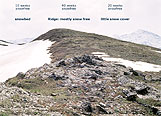 |
|
|
|
|
|
|
Global comparisons of biomass production of vegetation types are commonly done on a yearly basis. This may be valid if one wishes to account for the total contribution of certain biota to the globe's productivity or if one considers annual yield of certain products. A comparison that aims at the "ecological well being" and "physiological capacity" of certain biota will, however, not use the year, but the duration of the growing period for such a comparison. When biomass production is restricted to a 10 week snowfree period, the remaining 42 weeks under snow pack are of little relevance for the judgement of the biological performance. |
1 - Snow pack controls the length of the growing period in extra-tropical mountains. |
|
||||||||||||||||||||||||||||||||
|
2 - Dashed bars illustrate the variance around the mean calculated from various data sets for humid regions. |
|
When based on the length of the growing season, the biomass production of closed alpine grassland is not different from the mean for other not-water-limited grasslands of the globe. In fact, the productivity does not differ from that of humid tropical forests. This is a masterpiece of evolution. The adaptation of plant physiology and development is so perfect that the last remaining factor limiting biomass production is the length of the growing period. Currently we do not know enough about the productivity of tropical alpine vegetation, such as the tussock grassland found on all tropical and subtropical mountains. Does their 12 month productivity still fit the pattern in Fig. 2? It is likely that the monthly alpine productivity in the tropics is less than in temperate mountains, because the productivity in a short growing season will profit from winter time mineralisation under snow and the accumulation of N in the snow pack (see Alpine plant nutrition). In seasonal alpine climates nutrients become available for a short pulse of growth in summer. Furthermore, the tropical alpine day lasts only c. 12 h, compared to 16 h in the temperate zone. |
3 - Tropical tussocks (Mexico, Pico de Orizaba 4050 m) |
29 August 2011 |
||
| |
||

